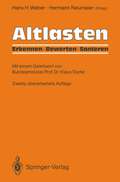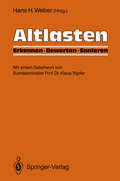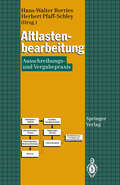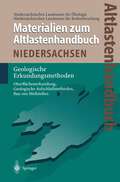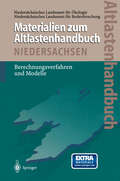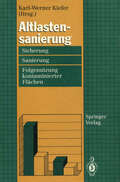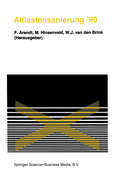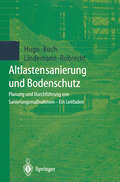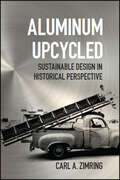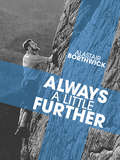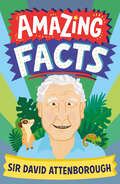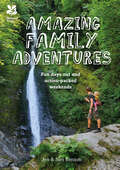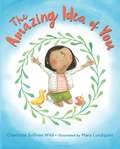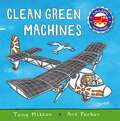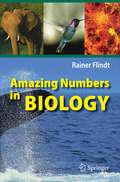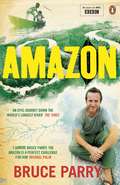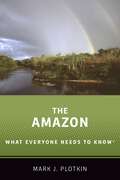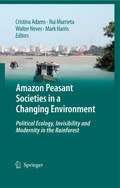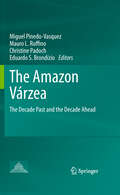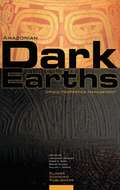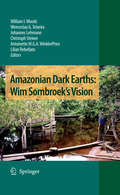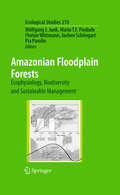- Table View
- List View
Altlasten: Erkennen, Bewerten, Sanieren
by W. Fresenius G. Mattheß H. Müller-Kirchenbauer K. Storp E. WeßlingBoden-, Luft- und Grundwasserverunreinigungen durch gesundheitsgefährdende Abfallstoffe z.B. durch Ablagerung auf industriell genutzten Flächen und auf Deponien oder durch Lekkagen von Tanklagern, Rohrleitungen oder Abwasserkanälen sind in vielen industrialisierten Ländern zu einem ernsten Problem geworden. Ein in Wissenschaft und Praxis der Sanierung von Altlasten, z.B. Deponien, Altablagerungen, alte Industriestandorte, erfahrenes Herausgeber- und Autorenteam gibt einen am Stand der Technik und am ökonomisch Machbaren orientierten und kritisch bewerteten Überblick über die Sanierungstechnologien. Für Industriebetriebe jeder Branche, für Zulassungs- und Gewerbeaufsichtsämter, Behörden für Abfall, Abwasser, Umweltschutz oder Altlastensanierung in Bund, Ländern und Gemeinden, für Unternehmen der Sanierungs-, Tiefbau- und Geotechnik, für Politiker, Unternehmer und Verwaltungsspitzen ist das Werk ein wertvoller Ratgeber. Für die zweite Auflage wurden alle Beiträge dem aktuellen Stand angepaßt; einige Beiträge sind komplett überarbeitet worden.
Altlasten: Erkennen, Bewerten, Sanieren
by Wilhelm Fresenius Georg Matthess Hanno Müller-Kirchenbauer Klaus Storp Erwin WeßlingBoden-, Luft- und Grundwasserverunreinigungen durch gesundheitsgefährdende Abfallstoffe, z. B. durch Ablagerung auf industriell genutzten Flächen und auf Deponien oder durch Leckagen von Tanklagern, Rohrleitungen oder Abwasserkanälen sind in vielen industrialisierten Ländern zu einem ernsten Problem geworden. Ein in Wissenschaft und Praxis der Sanierung von Altlasten erfahrenes Herausgeber- und Autorenteam gibt einen am Stand der Technik und am ökonomisch Machbaren orientierten und kritisch bewerteten Überblick über die Sanierungstechnologien. Für Industriebetriebe jeder Branche, für Zulassungs- und Gewerbeaufsichtsämter, Behörden für Abfall, Abwasser, Umweltschutz oder Altlastensanierung in Bund, Ländern und Gemeinden, für Unternehmen der Sanierungs-, Tiefbau- und Geotechnik, für Politiker, Unternehmer und Verwaltungsspitzen ist das Werk ein wertvoller Ratgeber. Aus dem Inhalt: Rechtliche Fragen und Öffentlichkeit.- Erfassen und Bewerten.- Sanierungsverfahren.- Überwachung.
Altlastenhandbuch des Landes Niedersachsen. Materialienband: Geologische Erkundungsmethoden
by M. Heinisch G. Dörhöfer H. RöhmAltlastenhandbuch des Landes Niedersachsen Materialienband: Berechnungsverfahren und Modelle
by Wolfgang Kinzelbach Axel Voss Randolf Rausch Jean-Pierre Sauty Wen-Hsing Chiang C. Cordes S.Z. FangAnwendungsbezogener Einstieg in die komplexe numerische Modellierung im Altlastenbereich.Zusätzliche CD-ROM mit Programmen für die numerische Modellierung, Beispieldaten und editierbaren Quellen.
Altlastensanierung: Sicherung, Sanierung und Folgenutzung kontaminierter Flächen
by Karl-Werner KieferAltlastensanierung und Bodenschutz: Planung und Durchführung von Sanierungsmaßnahmen — Ein Leitfaden
by A. Hugo M. Koch H. Lindemann H. RobrechtDer inhaltliche Schwerpunkt liegt hier bei der Planung und Durchführung von Sanierungsmaßnahmen auf der Grundlage des kürzlich erlassenen Bundesbodenschutzgesetzes (BBodSchG). Zukünftigen bzw. bereits in der Praxis tätigen Sanierungsplanern und -technikern soll hier ein wirklichkeitsnaher und pragmatischer Maßstab für die künftige Tätigkeit mitgegeben werden. In einem schwerpunktmäßig technisch ausgerichteten Forschungs- und Arbeitsfeld sollen eine realistische Einschätzung des Machbaren entwickelt und Lösungsmöglichkeiten für die alltäglichen Schwierigkeiten aufgezeigt werden. Somit wird dem (zukünftigen) Praktiker das Werkzeug für ein effektives und erfolgreiches Arbeiten im Altlastenbereich an die Hand gegeben.
Aluminum Upcycled: Sustainable Design in Historical Perspective (Johns Hopkins Studies in the History of Technology)
by Carl A. ZimringBesides being the right thing to do for Mother Earth, recycling can also make money;¢;‚¬;€?particularly when it comes to upcycling, a zero waste practice where discarded materials are fashioned into goods of greater economic or cultural value. In Upcycling Aluminum, Carl A. Zimring explores how the metal;€™s abundance after World War II;¢;‚¬;€?coupled with the significant economic and environmental costs of smelting it from bauxite ore;¢;‚¬;€?led to the industrial production of valuable durable goods from salvaged aluminum. Beginning in 1886 with the discovery of how to mass produce aluminum, the book examines the essential part the metal played in early aviation and the world wars, as well as the troubling expansion of aluminum as a material of mass disposal. Recognizing that scrap aluminum was as good as virgin material and much more affordable than newly engineered metal, designers in the postwar era used aluminum to manufacture highly prized artifacts. Zimring takes us on a tour of post-1940s design, examining the use of aluminum in cars, trucks, airplanes, furniture, and musical instruments from 1945 to 2015. By viewing upcycling through the lens of one material, Zimring deepens our understanding of the history of recycling in industrial society. He also provides a historical perspective on contemporary sustainable design practices. Along the way, he challenges common assumptions about upcycling;€™s merits and adds a new dimension to recycling as a form of environmental absolution for the waste-related sins of the modern world. Raising fascinating questions of consumption, environment, and desire, Upcycling Aluminum is for anyone interested in industrial and environmental history, discard studies, engineering, product design, music history, or antiques.
Aluminum Upcycled: Sustainable Design in Historical Perspective (Johns Hopkins Studies in the History of Technology)
by Carl A. ZimringBesides being the right thing to do for Mother Earth, recycling can also make money;¢;‚¬;€?particularly when it comes to upcycling, a zero waste practice where discarded materials are fashioned into goods of greater economic or cultural value. In Upcycling Aluminum, Carl A. Zimring explores how the metal;€™s abundance after World War II;¢;‚¬;€?coupled with the significant economic and environmental costs of smelting it from bauxite ore;¢;‚¬;€?led to the industrial production of valuable durable goods from salvaged aluminum. Beginning in 1886 with the discovery of how to mass produce aluminum, the book examines the essential part the metal played in early aviation and the world wars, as well as the troubling expansion of aluminum as a material of mass disposal. Recognizing that scrap aluminum was as good as virgin material and much more affordable than newly engineered metal, designers in the postwar era used aluminum to manufacture highly prized artifacts. Zimring takes us on a tour of post-1940s design, examining the use of aluminum in cars, trucks, airplanes, furniture, and musical instruments from 1945 to 2015. By viewing upcycling through the lens of one material, Zimring deepens our understanding of the history of recycling in industrial society. He also provides a historical perspective on contemporary sustainable design practices. Along the way, he challenges common assumptions about upcycling;€™s merits and adds a new dimension to recycling as a form of environmental absolution for the waste-related sins of the modern world. Raising fascinating questions of consumption, environment, and desire, Upcycling Aluminum is for anyone interested in industrial and environmental history, discard studies, engineering, product design, music history, or antiques.
Always a Little Further: A classic tale of camping, hiking and climbing in Scotland in the thirties
by Alastair BorthwickAlastair Borthwick’s classic tale of camping, hiking and climbing tells of the freedom and fellowship enjoyed by climbers in Scotland in the 1930s. His beautiful, vivid descriptions of the landscape are only rivalled by his colourfully drawn, highly entertaining cast of characters, all of whom are passionate about the outdoors and their place within it. Borthwick takes his reader - via road, campsite and bothy - from Arrochar to Glencoe; from the Cuillin to Lairig Ghru. Encounters with tramps, tinkers and hawkers, and of hitching to Ben Nevis in a lorry full of dead sheep, are all described in Borthwick's light-hearted style. He weaves a hilarious tale, aided by the eccentric folk he meets, and this light-hearted read continues to delight, decades after it was first published. Always A Little Further is essential reading for any climber, or indeed anyone, who longs to be transported from the mundane day to day to the wilds of Scotland.
Amazing Facts Sir David Attenborough (Amazing Facts Every Kid Needs to Know)
by Hannah WilsonBursting with fascinating facts for impressing friends, parents, grandparents and teachers – perfect for curious children everywhere!
Amazing Family Adventures
by Jen Benson Sim BensonWhether orienteering, building dens or making a house for a hedgehog, this guide is the ideal way for all the family to interact with wildlife and nature and find adventures in wild places.
The Amazing Idea of You
by Mary Lundquist Charlotte Sullivan WildFans of Emily Winfield Martin will delight in this loving, gorgeously illustrated story that celebrates new life. Hidden inside every living thing is an idea. That idea can sprout, sing, wriggle, take wing . . . into something amazing!Exploring beginnings both small and great, The Amazing Idea of You bonds the human and natural worlds in a lyrical burst of celebration. So dig deep, fly high, look around, and find the extraordinary inside everything . . . including YOU!
The Amazing Idea of You
by Mary Lundquist Charlotte Sullivan WildFans of Emily Winfield Martin will delight in this loving, gorgeously illustrated story that celebrates new life. Hidden inside every living thing is an idea. That idea can sprout, sing, wriggle, take wing . . . into something amazing!Exploring beginnings both small and great, The Amazing Idea of You bonds the human and natural worlds in a lyrical burst of celebration. So dig deep, fly high, look around, and find the extraordinary inside everything . . . including YOU!
Amazing Machines: Clean Green Machines
by Tony MittonAmazing Machines: Green Machines follows the animal team as they discover the latest eco-friendly inventions, from electric bikes and green buses to solar panels and energy found underground! Each page is filled with details that machine-mad kids will love.From water dams to electric cars, the internationally bestselling Amazing Machines series is the perfect way for children to learn about all sorts of machines and vehicles! Each book introduces a new vehicle or machine and the many jobs it can do. Bright, engaging artwork and simple, rhyming text combine to make these fantastic books for young children. Kids will love getting to know the friendly, animal characters who feature throughout the series and reading about their fast-paced adventures
Amazing Numbers in Biology
by Rainer FlindtThis book of tables provides comparative data from the fields of zoology, botany, microbiology, and human biology. It is a "must" for everyone interested in biology but also of help for all parents to address questions such as "Mama/Papa, how old can a ... be?" The plain facts of life from all areas of biology, including such topics as growth rates of hair and nails, and ages and weights of seeds are simply fascinating. Biology comes alive in this comprehensive and entertaining reference work. Warning: Anybody who begins browsing through this book will not easily stop reading!
Amazon: An Extraordinary Journey Down The Greatest River On Earth
by Bruce ParryExplorer Bruce Parry is embarking on yet another epic journey: down the Amazon - the world's greatest river, its largest forest, the most bio-diverse habitat on the planet and home to some of the last uncontacted tribes left on Earth. It's one hell of a trip, as Parry travels over 6,000 kms by foot, light aircraft and boat to meet and live with tribesmen, coca growers, loggers and illegal miners.Written in diary form, Amazon gives a rare insight into the ways of life that have existed since the dawn of time and are about to disappear forever.Illness, accidents, and all manner of unforeseen mishaps test Parry's strength every step of the way, but fans will know from Tribe that this man's thirst for new experiences, and his amazing resilience, knows no boundaries. Armchair travel and adventure doesn't get any better than this.
The Amazon: What Everyone Needs to Know® (What Everyone Needs to Know)
by Mark J. PlotkinThe Amazon is a land of superlatives. The complex ecosystem covers an area about the size of the continental U.S. The Amazon River discharges 57 million gallons of water per second--in two hours, this would be enough to supply all of New York City's 7.5 million residents with water for a year. Its flora and fauna are abundant. Approximately one of every four flowering plant species on earth resides in the Amazon. A single Amazonian river may contain more fish species than all the rivers in Europe combined. It is home to the world's largest anteater, armadillo, freshwater turtle, and spider, as well as the largest rodent (which weighs over 200 lbs.), catfish (250 lbs.), and alligator (more than half a ton). The rainforest, which contains approximately 390 billion trees, plays a vital role in stabilizing the global climate by absorbing massive amounts of carbon dioxide--or releasing it into the atmosphere if the trees are destroyed. Severe droughts in both Brazil and Southeast Asia have been linked to Amazonian deforestation, as have changing rainfall patterns in the U.S., Europe, and China. The Amazon also serves as home to millions of people. Approximately seventy tribes of isolated and uncontacted people are concentrated in the western Amazon, completely dependent on the land and river. These isolated groups have been described as the most marginalized peoples in the western hemisphere, with no voice in the decisions made about their futures and the fate of their forests. In this addition to the What Everyone Needs to Know® series, ecologist and conservation expert, Mark J. Plotkin, who has spent 40 years studying Amazonia, its peoples, flora, and fauna. The Amazon offers an engaging overview of this irreplaceable ecosystem and the challenges it faces.
Amazon Peasant Societies in a Changing Environment: Political Ecology, Invisibility and Modernity in the Rainforest
by Cristina Adams Mark Harris Rui S. S. Murrieta Walter A. NevesAmazonia is never quite what it seems. Despite regular attention in the media and numerous academic studies the Brazilian Amazon is rarely appreciated as a historical place home to a range of different societies. Often left invisible are the families who are making a living from the rivers and forests of the region. Broadly characterizing these people as peasants Amazon Peasant Societies in a Changing Environment seeks to bring together research by anthropologists, historians, political ecologists and biologists. A new paradigm emerges which helps understand the way in which Amazonian modernity has developed. This book addresses a comprehensive range of questions from the politics of conservation and sustainable development to the organization of women’s work and the diet and health of Amazonian people. Apart from offering an analysis of a neglected aspect of Amazonia this collection represents a unique interdisciplinary exercise on the nature of one of the most beguiling regions of the world.
The Amazon Várzea: The Decade Past and the Decade Ahead
by Miguel Pinedo-Vasquez, Mauro L. Ruffino, Christine Padoch and Eduardo S. BrondízioThis book takes a multi-disciplinary and critical look at what has changed over the last ten years in one of the world's most important and dynamic ecosystems, the Amazon floodplain or várzea. It also looks forward, assessing the trends that will determine the fate of environments and people of the várzea over the next ten years and providing crucial information that is needed to formulate strategies for confronting these looming realities.
AMAZON WENK C: What Everyone Needs to Know® (What Everyone Needs to Know)
by Mark J. PlotkinThe Amazon is a land of superlatives. The complex ecosystem covers an area about the size of the continental U.S. The Amazon River discharges 57 million gallons of water per second--in two hours, this would be enough to supply all of New York City's 7.5 million residents with water for a year. Its flora and fauna are abundant. Approximately one of every four flowering plant species on earth resides in the Amazon. A single Amazonian river may contain more fish species than all the rivers in Europe combined. It is home to the world's largest anteater, armadillo, freshwater turtle, and spider, as well as the largest rodent (which weighs over 200 lbs.), catfish (250 lbs.), and alligator (more than half a ton). The rainforest, which contains approximately 390 billion trees, plays a vital role in stabilizing the global climate by absorbing massive amounts of carbon dioxide--or releasing it into the atmosphere if the trees are destroyed. Severe droughts in both Brazil and Southeast Asia have been linked to Amazonian deforestation, as have changing rainfall patterns in the U.S., Europe, and China. The Amazon also serves as home to millions of people. Approximately seventy tribes of isolated and uncontacted people are concentrated in the western Amazon, completely dependent on the land and river. These isolated groups have been described as the most marginalized peoples in the western hemisphere, with no voice in the decisions made about their futures and the fate of their forests. In this addition to the What Everyone Needs to Know® series, ecologist and conservation expert, Mark J. Plotkin, who has spent 40 years studying Amazonia, its peoples, flora, and fauna. The Amazon offers an engaging overview of this irreplaceable ecosystem and the challenges it faces.
Amazonian Dark Earths: Origin Properties Management
by Johannes Lehmann Dirse C. Kern Bruno Glaser William I. WoodsDark Earths are a testament to vanished civilizations of the Amazon Basin, but may also answer how large societies could sustain intensive agriculture in an environment of infertile soils. This book examines their origin, properties, and management. Questions remain: were they intentionally produced or a by-product of habitation. Additional new and multidisciplinary perspectives by leading experts may pave the way for the next revolution in soil management in the humid tropics.
Amazonian Dark Earths: Wim Sombroek's Vision
by Christoph Steiner Antoinette M. G. A. WinklerPrins Lilian Rebellato William I. Woods Wenceslau G. Teixeira Johannes LehmannAmazonian soils are almost universally thought of as extremely forbidding. However, it is now clear that complex societies with large, sedentary populations were present for over a millennium before European contact. Associated with these are tracts of anomalously fertile, dark soils termed ‘terra preta’ or dark earths. These soils are presently an important agricultural resource within Amazonia and provide a model for developing long-term future sustainability of food production in tropical environments. The late Dutch soil scientist Wim Sombroek (1934-2003) was instrumental in bringing the significance of these soils to the attention of the world over four decades ago. Wim saw not only the possibilities of improving the lives of small holders throughout the world with simple carbon based soil technologies, but was an early proponent of the positive synergies also achieved in regards to carbon sequestration and global climatic change abatement. Wim’s vision was to form a multidisciplinary group whose members maintained the ideal of open collaboration toward the attainment of shared goals. Always encouraged and often shaped by Wim, this free association of international scholars termed the “Terra Preta Nova” Group came together in 2001 and has flourished. This effort has been defined by enormous productivity. Wim who is never far from any of our minds and hearts, would have loved to share the great experience of seeing the fruits of his vision as demonstrated in this volume.
Amazonian Floodplain Forests: Ecophysiology, Biodiversity and Sustainable Management (Ecological Studies #210)
by Wolfgang J. Junk, Maria T. F. Piedade, Florian Wittmann, Jochen Schöngart and Pia ParolinCentral Amazonian floodplain forests are an unique and endangered ecosystem. The forests grow in areas that are annually flooded by large rivers during mean periods of up to 8 months and at depths of up to 10 m. Despite this severe stress, these forests consist of over 1,000 species and are by far the most species-rich floodplain forests worldwide. The trees show a broad range of morphological, anatomical, physiological, and phenological adaptations that enable them not only to survive the adverse environmental conditions, but also to produce large amounts of biomass when the nutrient levels in water and soils are sufficiently high. This is the case in the floodplains of white-water rivers, which are used for fisheries, agriculture, and cattle-ranching but which also have a high potential for the production of timber and non-timber products, when adequately managed. Latest research on ecophysiology gives insight how tree species adapt to the oscillating flood-pulse focusing on their photosynthesis, respiration, sap flow, biochemistry, phenology, wood and leave anatomy, root morphology and functioning, fruit chemistry, seed germination, seedling establishment, nitrogen fixation and genetic variability. Based on tree ages, lifetime growth rates and net primary production, new concepts are developed to improve the sustainability of traditional forest managements in the background of an integrated natural resource management. This is the first integrative book on the functioning and ecologically oriented use of floodplain forests in the tropics and sub-tropics.It provides fundamental knowledge for scientist, students, foresters and other professionals on their distribution, evolution and phytogeography. “This book is an excellent testimony to the interdisciplinary collaboration of a group of very dedicated scientists to unravel the functioning of the Amazonian Floodplain forests. They have brought together a highly valuable contribution on the distribution, ecology, primary production, ecophysiology, typology, biodiversity, and human use of these forests offering recommendations for sustainable management and future projects in science and development of these unique wetland ecosystems. It lays a solid scientific foundation for wetland ecologists, foresters, environmentalists, wetland managers, and all those interested in sustainable management in the tropics and subtropics.” Brij Gopal, Executive Vice President International Society for Limnology (SIL).
